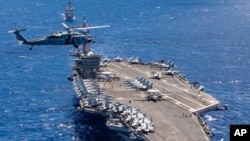For the better part of a decade, the People’s Republic of China has claimed most of the South China Sea as its own, based on vague historical claims and a map depicting nine dashes enclosing most of the 3.5 million square kilometer sea. This despite a July 2016 ruling by an Arbitral Tribunal which rejected many of China’s maritime claims as lacking a basis in international law. Included within the disputed area are numerous uninhabited islands, shoals, and submerged features, as well as large oil and natural gas deposits and rich fishing waters. It is also one of the world’s busiest shipping lanes.
In mid-January, the United States Department of State issued a study on the PRC’s maritime claims in the South China Sea. It is the 150th report of the longstanding legal and technical Limits in the Seas series that examines national maritime claims and boundaries and assesses their consistency with international law.
The report summarizes the PRC’s sovereignty claims over maritime features that are submerged at high tide and therefore are not islands. It claims the right to draw straight lines around large areas connecting widely dispersed maritime features, claiming the areas of ocean space within those lines. The PRC extrapolates claims of internal waters, territorial sea, exclusive economic zone, and continental shelf from these island groups. Finally, the PRC claims “historic rights” in the South China Sea, based on an arbitrary nine-dash water border around the sea’s perimeter, drawn after World War II.
The study relies on the PRC’s official statements and communications to assess the consistency of the PRC’s maritime claims with international law. It concludes that first, the PRC’s sovereignty claims over maritime features that do not meet the international law definition of an “island” are not valid. Second, straight baselines that would enclose South China Sea “island groups” are similarly not consistent with international law, and neither are claims of maritime zones extrapolated from those “island groups.” And finally, the PRC’s claim to “historic rights in the South China Sea” has no legal basis and is asserted by the PRC without specific indication regarding the nature or geographic extent of the “historic rights” claimed.
“The goal of defending the rules-based order is not to keep any country down,” said Secretary of State Antony Blinken. “Rather, it’s to protect the right of all countries to choose their own path, free from coercion and intimidation.”














